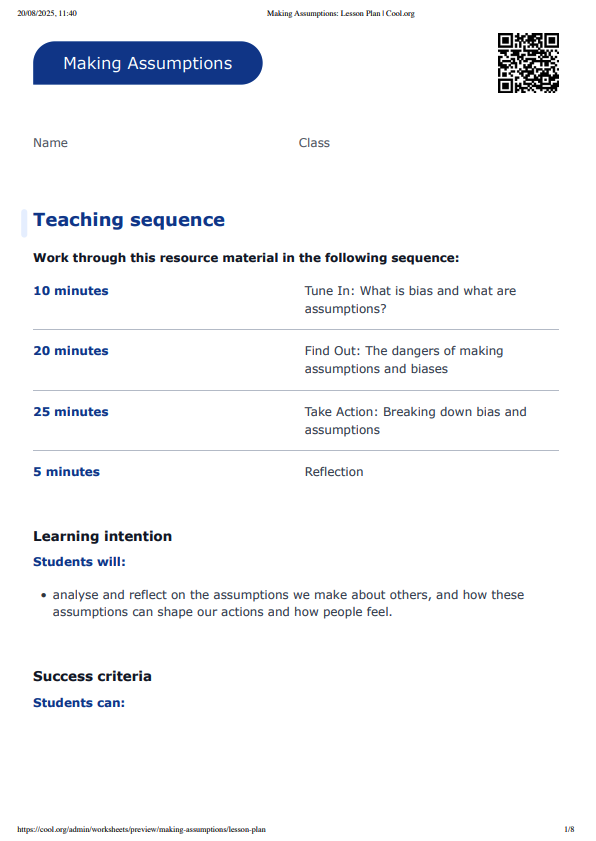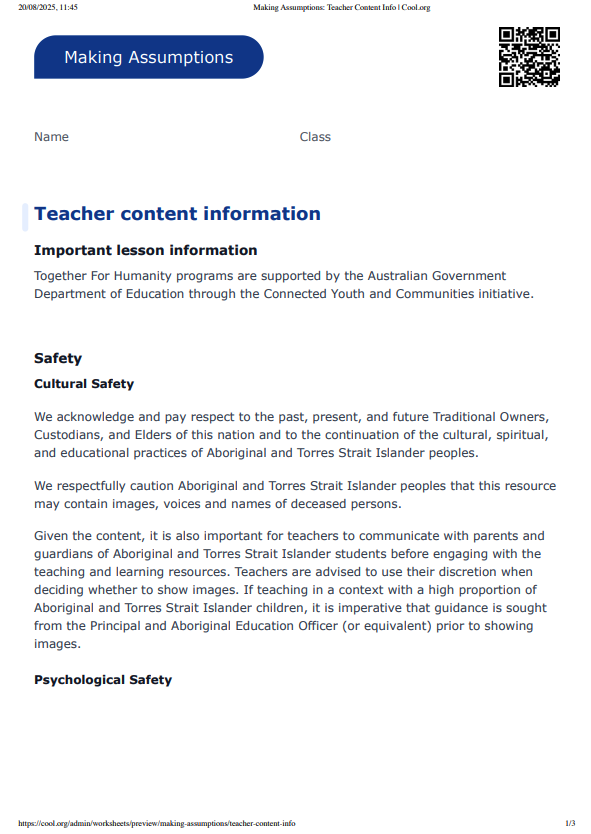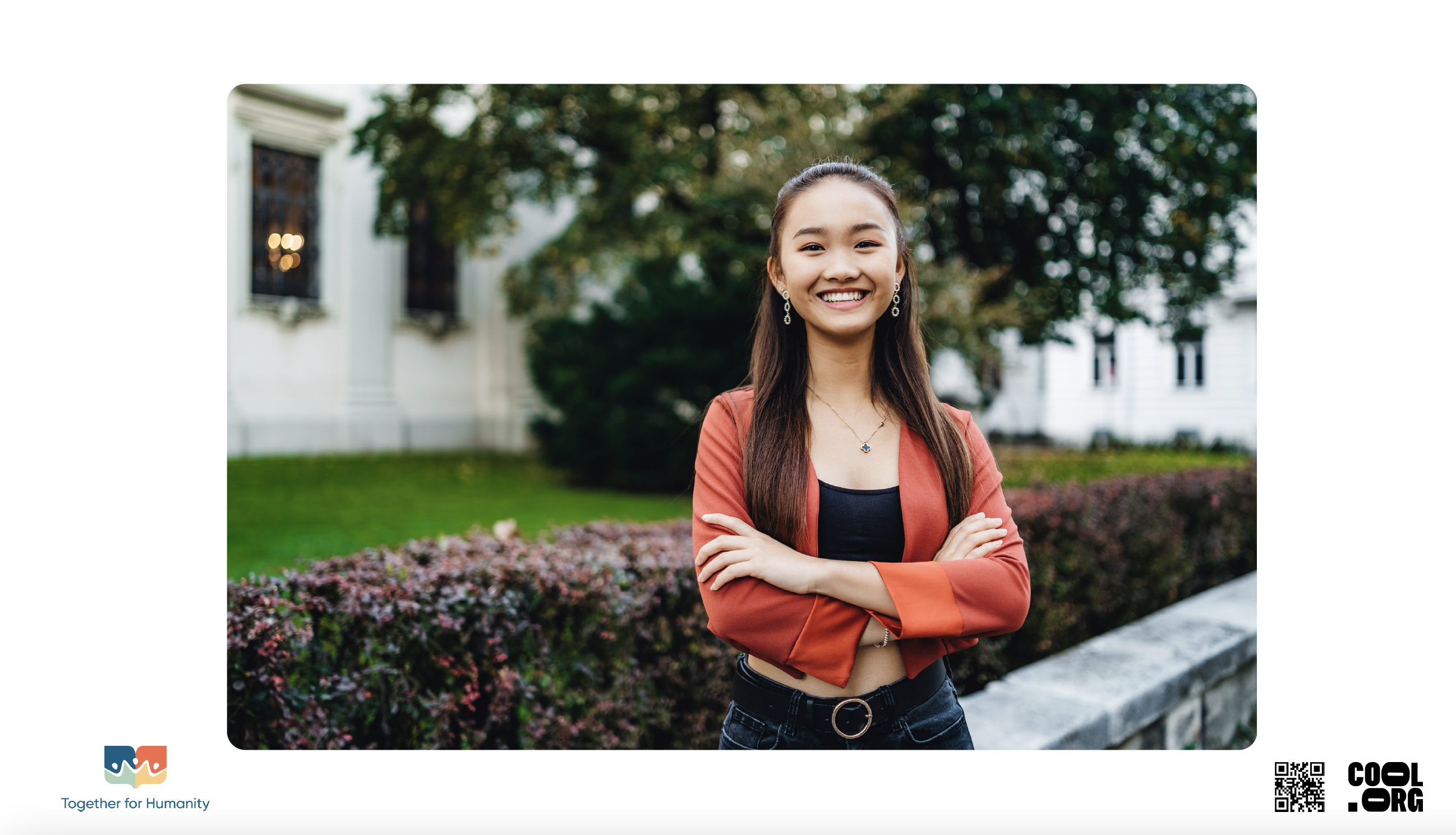Lesson summary
Students will explore how the assumptions and generalisations we make about others influence biases and the way we treat people. They will examine some of the factors that shape attitudes and judgments that lead to stereotyping. Students will be guided to challenge their own assumptions and engage in empathy-building activities to reflect on the effect of making generalisations and labelling. Students will finish the lesson by creating personal pledges to foster more respectful and inclusive communities.
Learning intentions
Students will:
- analyse and reflect on the assumptions we make about others, and how these assumptions can shape our actions and how people feel.
Success criteria
Students can
- identify and explain common assumptions and generalisations people make about others
- analyse their own assumptions and reflect on how these assumptions might affect others
- create positive, inclusive alternatives to limiting labels and commit to actions that challenge unfair assumptions and promote respect in their community.
Lesson guides and printables
Curriculum links
Select your curriculum from the options below.
Lesson details
Skills
This lesson is designed to build students’ competencies in the following skills:
- adaptability
- critical thinking
- communication
- empathy
- intercultural understanding
- global citizenship
Curriculum Mapping
Australian Curriculum (v9.0) content description:
Year 7 and 8, Health and Physical Education
Students learn to
- analyse and reflect on the influence of values and beliefs on the development of identities (AC9HP8P01)
Relevant parts of Year 7 and 8 achievement standards: Students analyse factors that influence identities, emotions and responses to change, and describe strategies to respond to these influences.
Victorian curriculum (2.0)
Year 7 and 8, Health and Physical Education
Students learn to
- analyse and reflect on the influence of values and beliefs on the development of identities (VC2HP8P01)
Relevant parts of Year 7 and 8 achievement standards: Students analyse factors that influence emotional responses and justify strategies to manage emotions.
NSW Syllabus outcomes:
A student can
- assess the influence of contextual factors on attitudes and behaviours to propose strategies that enhance safety, health and wellbeing (PH4-SHW-01)
General capabilities: Critical and Creative Thinking, Ethical Understanding, Personal and Social Capability
Cross-curriculum priority: Aboriginal and Torres Strait Islander Histories and Cultures
Level of teacher scaffolding: High – teachers will need to moderate student discussion and support student work.
UN Sustainable Development Goals
Target 4.7: By 2030, ensure that all learners acquire the knowledge and skills needed to promote sustainable development, including, among others, through education for sustainable development and sustainable lifestyles, human rights, gender equality, promotion of a culture of peace and non-violence, global citizenship and appreciation of cultural diversity and of culture’s contribution to sustainable development.
Resources Required
- Device to project onto a screen
- Making Assumptions Images
- Sticky notes
Additional Info
Together for Humanity is an inclusive, not-for-profit educational organisation that works with school communities to combat prejudice and advance belonging and inclusion. We offer a range of student programs linked to the Australian Curriculum, Teacher Professional Learning and online learning for students and teachers. Our work contributes to a more socially cohesive Australian society that values and respects cultural and religious diversity.
Related Professional Learning
Respectful Terminology: Engaging with First Nations peoples
Quick Summary: This course equips educators with the knowledge and confidence to use respectful terminology when engaging with Aboriginal and Torres Strait Islander peoples, histories and cultures.




Welcome back!
Don't have an account yet?
Log in with:
Create your free Cool.org account.
Many of our resources are free, with an option to upgrade to Cool+ for premium content.
Already have an account?
Sign up with:
By signing up you accept Cool.org's Terms and Conditions(Opens in new tab) and Privacy Policy(Opens in new tab).